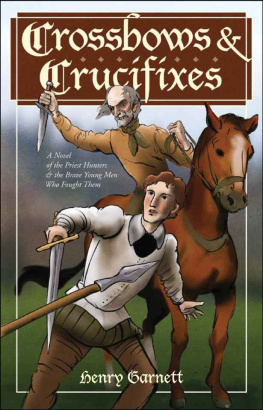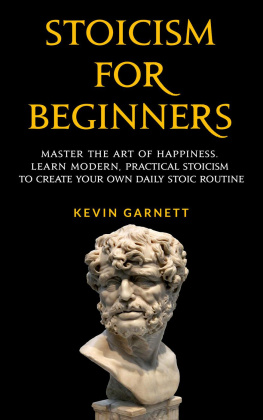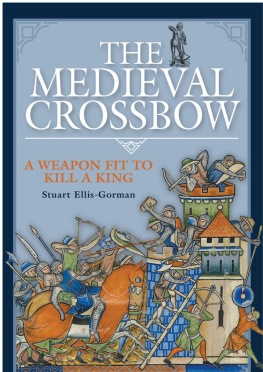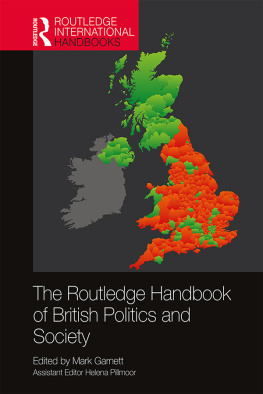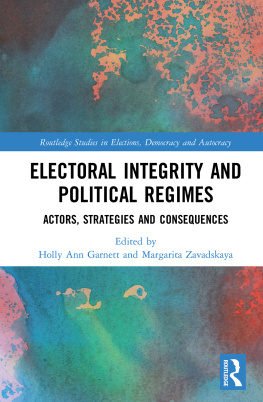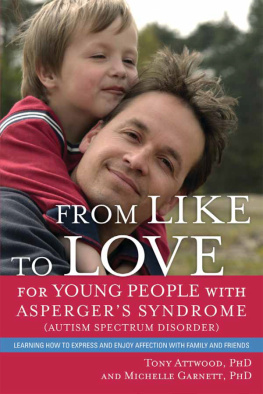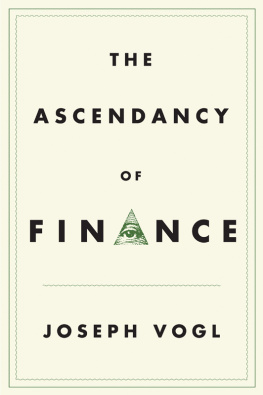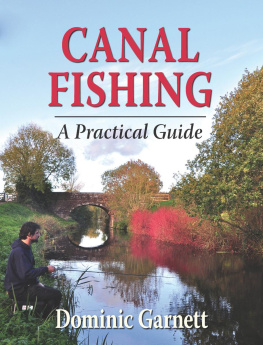Henry Garnett - Crossbows & Crucifixes
Here you can read online Henry Garnett - Crossbows & Crucifixes full text of the book (entire story) in english for free. Download pdf and epub, get meaning, cover and reviews about this ebook. year: 2013, publisher: Sophia Press Institute, genre: Detective and thriller. Description of the work, (preface) as well as reviews are available. Best literature library LitArk.com created for fans of good reading and offers a wide selection of genres:
Romance novel
Science fiction
Adventure
Detective
Science
History
Home and family
Prose
Art
Politics
Computer
Non-fiction
Religion
Business
Children
Humor
Choose a favorite category and find really read worthwhile books. Enjoy immersion in the world of imagination, feel the emotions of the characters or learn something new for yourself, make an fascinating discovery.
- Book:Crossbows & Crucifixes
- Author:
- Publisher:Sophia Press Institute
- Genre:
- Year:2013
- Rating:5 / 5
- Favourites:Add to favourites
- Your mark:
- 100
- 1
- 2
- 3
- 4
- 5
Crossbows & Crucifixes: summary, description and annotation
We offer to read an annotation, description, summary or preface (depends on what the author of the book "Crossbows & Crucifixes" wrote himself). If you haven't found the necessary information about the book — write in the comments, we will try to find it.
Crossbows & Crucifixes — read online for free the complete book (whole text) full work
Below is the text of the book, divided by pages. System saving the place of the last page read, allows you to conveniently read the book "Crossbows & Crucifixes" online for free, without having to search again every time where you left off. Put a bookmark, and you can go to the page where you finished reading at any time.
Font size:
Interval:
Bookmark:
Crossbows and Crucifixes
A Novel of the Priest Hunters and the Brave Young Men Who Fought Them
Henry Garnett

Also by Henry Garnett from Sophia Institute Press:
The Blood-Red Crescent
Crossbows and Crucifixes was first published in 1962 by Doubleday and Company, Inc., Garden City, New York, under the title A Trumpet Sounds.
Copyright 2009 Sophia Institute Press
Printed in the United States of America
All rights reserved
Cover design by Ted Schluenderfritz
No part of this book may be reproduced, stored in a retrieval system, or transmitted in any form, or by any means, electronic, mechanical, photocopying, or otherwise, without the prior written permission of the publisher, except by a reviewer, who may quote brief passages in a review.
Sophia Institute Press
Box 5284, Manchester, NH 03108
1-800-888-9344
www.SophiaInstitute.com
This book is for my mother, who first introduced me to the secret country on the borders of Worcestershire and Herefordshire, in which much of the action in this story takes place.
Yet ever and anon a trumpet sounds
From the hid battlements of eternity.
Francis Thompson
Authors Note
You might be tempted to wonder, as you read this book, how much of it is true and how much I have invented for your entertainment. I would like, therefore, in the very beginning to assure you that nothing happens to Nicholas and his friends that did not, or could not, have happened to Catholics in sixteenth-century England. The wonder is that any Catholic families survived, as Catholics, to tell the tale. To explain why there was so much intolerance, I should have to write for you another book. You must take my word for the fact that there were both Catholics and Protestants who would go to any lengths to force their point of view on those of the other side. You should not have any difficulty in thinking of a modern parallel. Politics came into it, too, and the mixture of religion and politics is very explosive.
There are a few more facts about the book that might interest you. The part of the prayer quoted early in chapter 1 comes from The Prayer Book of Queen Elizabeth, first published in 1558. This prayer was added in 1569 after the Rebellion of the North. On the lighter side, you will be amused to know that the football story, also in chapter 1, is taken from the records of the real St. Peters School, York, and that Christopher Dobson lived and took part in it.
You may accept as fact all that you read about the men who sailed in the ships called trows on the river Severn. They continued earning and stealing their living on that river until the last trow was built a century ago. Their legs that swelled like skittle pins were the same then as in this story.
Finally, I think I should tell you that the secret valley of the Sapey exists to this day and very much as I have described it. It is extremely difficult to get into, although I have, perhaps, for the purpose of the story, somewhat exaggerated the difficulty. But then, even I dont know what it was like in 1585.
By the way, a pursuivant was an official agent of the government. His duty was to enforce the laws against Catholics and to make sure they paid the fines imposed on them for being Catholics. Papist was a term of contempt and hostility applied to Catholics in the Elizabethan period. In time, many Catholics used it in referring to themselves as a term of honor.
Henry Garnett London, 1961
Chapter 1
Schoolboys Tale
The July sun of 1585 slanted through the mullioned windows of the classroom, and in the yellow beams, a myriad dust motes danced. It patterned the bare boards of the floor and picked out here and there, in black shadow, deeply engraved names on the desktops.
The afternoon light shone directly on the head of a boy seated in a corner of the room and, with his every slight movement, revealed tints of auburn in his brown hair. His eyes were bent on the lid of his desk, and, with the tip of his tongue protruding from his lips, he was absorbed in deepening the letters of his own name carved in the wood. The small knife that he used for sharpening his quill pens was being drawn along the lower limb of the letter E when the master called his class to attention.
Nicholas Thorpe allowed the book he had been using as a shield to hide his carving from the teachers eyes, to fall flat on the desk. He slipped his knife into his doublet and rose to his feet in one lithe movement. He revealed himself as a tall youth, taller than his classmates, with soft down where his beard would be, blurring the outline of a firm chin.
At a second order, the boys stepped out of their desks to form files in the aisles. Nicholas, at the age of fifteen, was the oldest as well as the tallest of his fellows, and so he was the last to leave the classroom.
Outside the buildings of St. Peters School, York, Nicholas settled his soft bonnet on his head. He was soberly and rather shabbily dressed, and the white falling bands turned down over the collar of his gray doublet were crumpled and soiled. It was the end of the school week. But his netherstocks were braced tightly and showed, as he walked, the promise of powerful muscles in calves and thighs.
The column of boys marched through Bootham Bar the gate in the walls of York whose battlements and turrets frown down on the traveler and passed on to the Minster. The gloom and chill inside the great cathedral struck Nicholas like a physical blow as he entered, as it always did, but on this summer afternoon, he did not look around the bare nave or peer at the even more naked chancel and sanctuary. The scars on the stone where the images of the saints had been roughly torn from their niches did not cause him a half-understood pain as they had in the past. He was preoccupied with his own thoughts and shared in the standing, sitting, and kneeling that seemed such an essential part of the ritual of the new State Church, without any real consciousness of what was going on about him.
Nicholas listened with only half his mind to the droning voice of the clergyman, until the words of the prayer for the queen, or the words of the prayer against Catholics it seemed to come to the same thing, Nicholas thought forced themselves on his attention.
... Defend, O Lord, Thy servant and our governor under Thee, our Queen Elizabeth, and all Thy people committed to her charge. O Lord, withstand the cruelty of all those which be common enemies as well to the truth of Thy eternal word, as to their own natural Prince and Country, and manifestly to this crown and realm of England... Make soft and tender the stony hearts of all those that exalt themselves against Thy truth, and seek either to trouble the quiet of this realm of England, or to oppress the crown of the same...
That prayer was written a year before I was born, in 1569, Nicholas said to himself, after the failure of the rising of the Earls of Northumberland and Westmorland. They wanted to put Queen Mary of Scotland on the throne of England and bring back the Old Faith. The only results were heads falling on Tower Hill far away in London, and hundreds of sturdy north-countrymen hanging by the neck from the branches of trees before their own cottage doors. He remembered the words of his headmaster, Master John Pullen, on the subject and suddenly realized why he was preoccupied.
Next pageFont size:
Interval:
Bookmark:
Similar books «Crossbows & Crucifixes»
Look at similar books to Crossbows & Crucifixes. We have selected literature similar in name and meaning in the hope of providing readers with more options to find new, interesting, not yet read works.
Discussion, reviews of the book Crossbows & Crucifixes and just readers' own opinions. Leave your comments, write what you think about the work, its meaning or the main characters. Specify what exactly you liked and what you didn't like, and why you think so.

